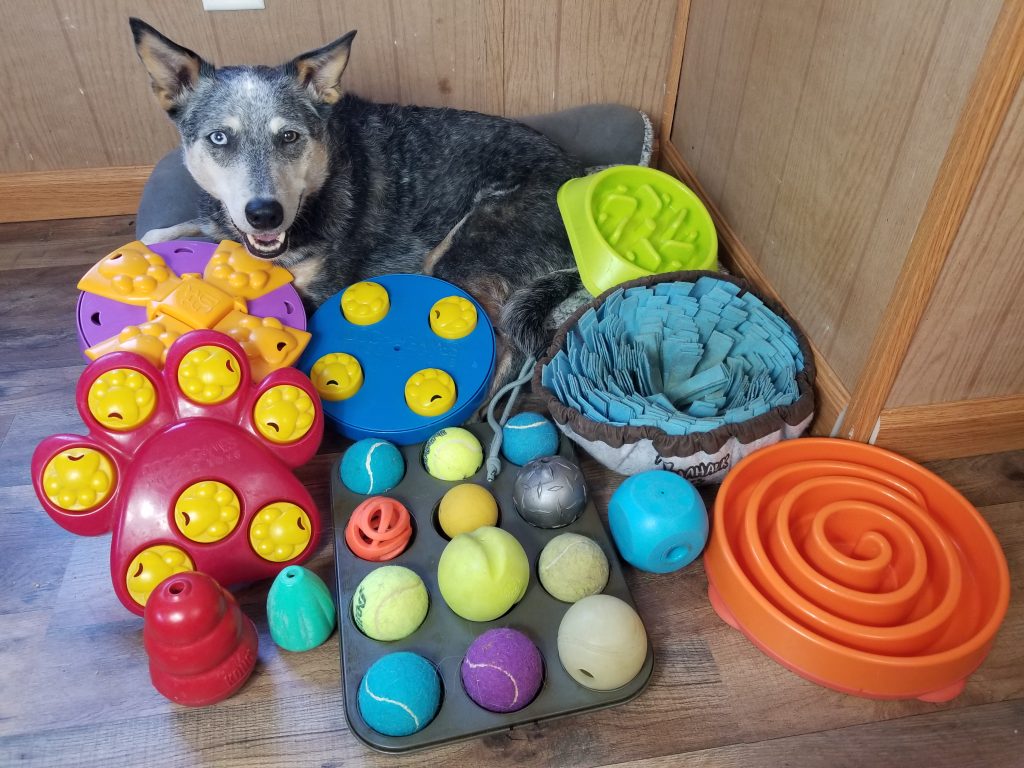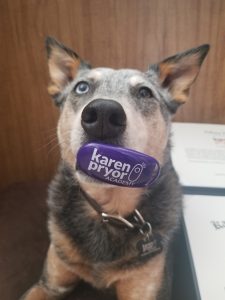
Positive reinforcement dog training has gained immense popularity in recent years for its humane and effective approach to teaching dogs new behaviors and modifying undesirable ones. However, like any widely adopted method, it has its fair share of misconceptions and myths and has been slow in the uptake for the general public who has been taught and exposed to dog training primarily through TV shows such as “The Dog Whisperer” or online social media ‘trainers’ who are unqualified and un-certified. These ‘trainers’ use the “Alpha Theory” to apply in their dog training provided by David Mech.
The Wildlife Biologists and Animal Behaviorists have since revoked their statement about the Alpha Theory in relation to dog training, apologizing and noting that the animals studied were unrelated wolves in captivity and they behaved nothing like wolves in the wild and that this does not apply to dogs and should NOT be used in training dogs! However, it takes some time for the updated information to be disseminated and taught to the general public. In this blog post, we’ll debunk five of the most common myths surrounding positive reinforcement dog training since people seem to think it’s “only about treats and love.”
Myth 1: Positive Reinforcement Is All About Treats
One of the most persistent misconceptions about positive reinforcement training is that it’s solely reliant on treats. While food can be a valuable tool for motivating and rewarding dogs and are absolutely the easiest to use to teach any animal species who don’t speak your language (and how else are you planning to communicate and get an animal who does not speak your language or understand you at all to listen to you?). However, positive reinforcement encompasses a broader range of rewards, including, but not limited to, praise, toys, play, space, scent, and physical touch such as massages. The key is to find what motivates your individual dog, as different dogs have different preferences. Food is certainly the easiest as all dogs eat food daily. Some dogs might not want to be touched so praise or tactile reinforcement wouldn’t work with them. Similarly, dogs have different taste palates and what one may find delicious, another one may have no interest in!
I found it interesting when I took Kronos on a Pack Walk and the other people said their dogs weren’t food motivated, yet their dogs kept sniffing the air toward the treats and some tried to break their stay because they wanted in on the treat giving that I was using to reinforce Kronos for maintaining his stay at a distance with duration (note I definitely brought the super stinky and high value food to do conditioning and have had this happen multiple times on Pack Walks while doing training with all of my dogs!). However, if your dog won’t take food, this is information that tells us your dog is too stressed by something in their environment which is making them not want to eat. When you lost a loved one or are afraid of something (say you saw a rattlesnake right by your foot), do you find you want to eat, play, laugh, do things or do you feel nauseous and off your food with the thought of it making you want to puke while maybe feeling super blah?
Do you have a working breed who is obsessed with play, biting, and movement? Or maybe a scent driven pup who LOVES following a trail and using their nose? Over time, as the dog learns the desired behavior, treats can be phased out or used intermittently while other forms of reinforcement, such as playing, sniffing, and walking become more prominent and primarily used. Though remember that when you stop expecting reinforcement for anything you do at work and are willing to accept a “Job well done!” from your boss instead of monetary payment is when you should plan to stop randomly reinforcing with food in training. And what I found most interesting is why do we “allow” and “expect” people to continue using treats and food when training wildlife, yet for dogs they “should do it just because?” Using food will certainly short cut the learning process and make it super easy which I’m personally all about the easiest way without it being stressful or unenjoyable to me or the animal!

Myth 2: Positive Reinforcement Doesn’t Address Behavioral Problems and Avoids Them
Some people believe that positive reinforcement training is only effective for teaching basic commands and tricks, and that it can’t address serious behavioral problems like aggression or anxiety. This is far from the truth. Positive reinforcement techniques can be applied to address a wide range of behavioral issues. In fact, it is often recommended for modifying problematic behaviors because it focuses on rewarding desired behaviors while setting up for success to prevent undesirable ones. What does this mean? If your dog likes to bark at people walking by the window, covering the windows or putting up plastic covers which make it difficult for them to see out while instead providing your dog a chew or stuffed meal Kong on a bed will set your dog up for success. Covering the window will not teach the dog what you want them to do, but it’s a good start and the first step in the right direction!
Giving a stuffed meal Kong on a bed will also reinforce your dog for laying down quietly chewing their toy which is directly incompatible with barking at the window (which is what you actually want them to do and this is the behavior you do want right?). Management will NEVER replace training! Covering the window may diminish the behavior, but it’s still NOT taught your dog to be relaxed and calm when they see strangers walking by. Using a front clip harness may manage a dog from pulling so it seems like the behavior is gone, but it will NOT teach the dog how to walk politely on the leash. If your dog is afraid of people, keeping your dog away from strangers will make your pup feel safe, but it doesn’t teach them how to feel safe in the presence and around strangers when you go out and about. Does this make sense? The first step would be not letting strangers interact with your dog and the next would be to work with a qualified trainer to teach your dog that not all strangers are scary! You can Find a Trainer on this directory near you.

Your dog snaps when you try to take a bone away that they’re chewing? First, what would you do if someone grabbed the fork from your hand as you were going to take a bite? A skilled positive reinforcement trainer can help dogs overcome aggression, anxiety, and other challenging behaviors through a systematic approach. What this means is that
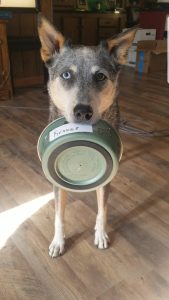
you absolutely can teach the dog to be comfortable with you taking things from them by giving them something even better so they will learn to trust you and look forward to you around their food. My dog, Kronos, loves to bring me the chews and toys he has and offering them to me hoping that I will give him something better! I love this. I also know if I ultimately had to take away something he had, he’d let me and be more than willing to give up the item to me. Sometimes he literally throws items at me, saying “Look! I brought you this! Treat please!” He’s very clear in his communication as he’ll then go over and stare at the treat jar then back at me asking for a treat. It’s up to me whether I want to continue to reinforce that or not which sometimes I do and some times I don’t for it to be a variable rate of reinforcement (meaning sometimes you win at the casino slots and sometimes you don’t).
Check out some professionals in action such as Michael Shikashio-an expert on dog aggression and also check out the Dog Aggression Conference to find successful and qualified professionals who work with “aggressive” dogs. In some instances, what you may notice is that some of the dogs shown in videos may not seem to be behaving aggressively-that means the trainer knows how to set up the dog for success and work with them. Stay far away from trainers who make the dog react to work them through the behavior. If you would be comfortable being thrown into a tub with your worst fear and strapped in or locked in a room with many of the things that you’re terrified of, that’s in essence what trainers who wrestle dogs through these behaviors are doing. Working with a dog who is actively not trying to eat the face off of the trainer is something skilled, qualified, and professional trainers do frequently and have been trained how to handle. It really should be like watching paint dry for the average pet owning person, although to a behavior nerd it’s fascinating to watch all the small nuances of head turn aways, ear movements, weight shifts, tail tucks, eyes narrowing (or widening) etc. in the videos.
Also many people think that Positive Reinforcement Trainers only work with “puppies and ‘easy'” dogs. If you look at the population on average, most pet owning families tend to own these “easier” breeds such as herding dogs and Labradors/Goldens or companion bred dogs. So by human density and breed preference this may seem true. Also, most people take their puppies to trainers to start teaching them and most trainers understand and know that preventing a problem before it occurs is eons easier than addressing the problem when it has already occurred and become ingrained. As the old adage goes, “an ounce of prevention is worth a pound of cure,” meaning that’s much easier to prevent behavior problems by teaching puppies proper body handling skills, crate training, settling training, giving them chew training, teaching them loose leash walking skills, etc. at an early age than the effort that is required to change a dog’s existing behavior which has been practiced for years. We can easily see this in our own animal species how kids are total sponges and love to learn and try new things and question everything, but as we age most people become set in their ways and are not open to, nor interested in learning new things!
An important thing to note is that you can only build on success in training. Puppy Culture is one program that’ll help you set your pup up to be the best family companion dog they can be from the get go! It’s even better if you can find a good breeder who uses this program with their pups!
Myth 3: Positive Reinforcement Training Takes Forever
Another misconception is that positive reinforcement training is time-consuming and slow compared to more punitive methods. While it’s true that positive reinforcement training may require more patience, kindness, and consistency from the handler to learn and implement when teaching the dog, overall it can actually produce quicker and more lasting results. Dogs tend to learn faster and retain their training better when they are motivated by positive experiences rather than fear or punishment. How quick were you to listen to your parents when they promised you a reward instead of threatened you to do something? And when you KNEW you were going to get a verbal reaming, how much did you drag your feet and do your best to put off, avoid interacting with, or running into your parents? This would be what is called avoidance behavior! And oh boy do I wish that my parent had leaned more on the promise of ice cream, kind words, or something that I wanted (maybe a new book or seeing a movie) instead of using the belt, hurtful verbal words, and physical punishment for things including a bad report card in elementary school!
Positive reinforcement training also builds a strong bond between you and your dog, making future training sessions more efficient. If you see your dog moving slowly to perform what you want them to do, this is them showing you they are confused, unsure of what you want, or they are trying to calm you down (ironically many people get more angry and frustrated because they think the dog is “disobeying them” which is not only the farthest thing from the truth, but also the opposite effect of what the dog is wanting and is actively trying to prevent by going oh so slowly although our primate brains are so impatient and want it NOW!). Your dog would be so relieved if you taught them what you wanted them to do and would be more than happy to do so! Using positive reinforcement you might see how snappy and responsive your pup becomes in responding to the given cues! They aren’t challenging you, fighting you, or not listening to you. They are completely lost-much like you would be if someone came up to you and started yelling at you in a foreign language then getting more and more mad because you aren’t listening to them and understanding them! Seriously, how could you NOT understand that “SOTJKJWETEO” means I want you to go pick up that book and bring it to me?!
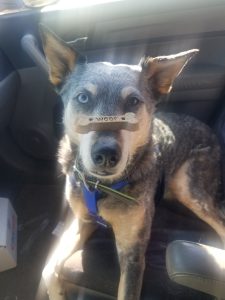 Myth 4: Positive Reinforcement Means You Can’t Correct Your Dog
Myth 4: Positive Reinforcement Means You Can’t Correct Your Dog
Some people worry that using positive reinforcement means they can never “correct” their dog’s behavior when necessary or they can’t say “no.” You’re more than welcome to say whatever you want to do your dog! You could say “Hufflepuff, Patronus, Pikachu, or Sparkplug” for all it matters to your dog and for it to all mean the same thing. This is how dogs are able to understand words and perform tons of behaviors in different languages and still be able to perform the behaviors! Have you seen the dog who has been taught behaviors using Harry Potter words? In reality, positive reinforcement training doesn’t eliminate the possibility of corrections; it simply encourages the use of humane and effective consequences. Really what it says is that dogs bark, dig, chew, and run so how can we set the dog up to have appropriate outlets for these behaviors we already know the dog is going to do? And if they do something we don’t want? Well, we’ve failed as the supposed to be more intelligent species with bigger brains and opposable thumbs. Positive reinforcement training is absolutely not permissive. Yes, you still train your dog how to walk politely on a loose leash without pulling you over, how to lay down on their bed quietly while you’re watching TV without barking at the people walking by the house, working on the computer, eating dinner, how to bark and how to be quiet on cue without having to yell at them so they understand what you’re asking and what you want, and how to have the dog that you want joining you out and about-most of this you would learn if you go through a Canine Good Citizen training class with your dog or puppy!
For an example of what you as the human could do when your dog jumps up on you trying to get attention, you go into another room and close the door. Or stand still with your arms crossed ignoring the dog or even turn your back away from the dog until they have four paws on the floor and calm down. You have just performed a ‘correction’ or ‘consequence’ that we’re taught as humans and told by society we need to have. Now imagine that you instead reinforce the four on the floor often by throwing treats to your dog for this stationing behavior. Then build duration for the standing. How quickly do you think your dog will understand that what you in fact want is for them to stand on all four while you pet them? Though it takes some serious self control for them as they are exhibiting excited greeting behavior and want so bad to celebrate with you! Behavior that is reinforced will be repeated, so if your pup gets all the treats, pets, and attention for keeping four paws on the floor, this body position will be repeated. If they get any attention for jumping up, this behavior will be repeated too. To diminish this behavior, you have to decide what you want (a calm dog) so that when you come back you will ignore the dog until they are calm and you have to be calm instead of being excited to greet your dog and excitingly greeting them. Some people may be easily able to do this, others enjoy how happy their dog is to see them and enjoy greeting them in turn. Difficult to have impulse control as the human isn’t it?
As another example, your dog barks and lunges at people and dogs because it wants to say hi? Walk away with your dog. Hopefully you’ve taught your dog an about turn behavior or how to follow you so you don’t have to just drag them away with the leash. You just performed a ‘correction’ by creating space and taking your dog further away from what they want. If you haven’t taught your dog to follow on lead, time to practice in less distracting environments then teach this behavior in the distracting environment with other dogs and people!
Your dog barks and lunges because it wants the scary things to go away and leave it alone? Still walk away and create space with your dog, although you will need professional assistance and guidance to help the dog feel safe as your dog is trying to increase distance by putting on this “embarrassing to you display” of behavior like you would from a shark, snake, spider, or whatever other scary thing. Your dog has learned this behavior makes them feel relief and safe. When feeling cornered, the options for any animal are to fight, flight, freeze, or fool around. Have you ever been in a conversation that honestly you wish would just stop and maybe you said something or snapped at the person, which while you regretted saying it later on, it ended the conversation in the moment and you were so relieved that it was over? That’s essentially what your dog is doing and the same reinforcement they receive and feel.
‘Corrections’ in positive reinforcement training often involve redirecting the dog’s attention to what you want them to do and reinforcing them for that or using time-outs and the removal of either the dog or what the dog wants rather than physical or verbal punishment. So instead of using the word correction, we like to ask “How can I set my dog up for success?” and “What do I want my dog to do?” Your puppy’s chewing on a cord? Remove the cord and puppy proof the environment by putting away/blocking off cords so they are out of puppy reach and provide appropriate chews for them to chew on instead! This is the equivalent of putting locks on cabinets so your kid will avoid eating dish soap or putting socket covers on outlets so your kid will learn to keep their hands safe from being electrocuted until they grow out of this stage and you’re able to explain to them with words as they learn to understand words. Would you rather be chasing your puppy around all the time worrying about what they get into or simply set up the environment so they can do what you want them to do? Setting up the environment for success as an approach helps the dog understand what is expected quickly without causing fear or stress for human or dog!
Myth 5: Positive Reinforcement Is One-Size-Fits-All
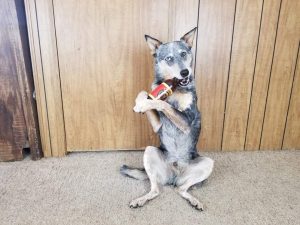
Positive reinforcement training is often wrongly perceived as a one-size-fits-all approach. However, every dog is unique, and what works for one may not work for another. Many use this as a reason for using different training methods with dogs and to justify how they’ve been training saying they aren’t able to make adjustments and need to keep doing what they’ve been doing! What this actually means is that some dogs love to run, some dogs love to dig, some dogs love to bite, some dogs love to swim, some dogs love to kill animals, and for others food trumps all! And just like trying to use hay for a wolf to train them would absolutely not work, dogs like different foods and may have no interest in hay or carrots like a horse would! What this means is that it’s important to know what foods your dog likes and doesn’t like. Similarly, much like people who have different interests and activities they enjoy (some people like beer, some people don’t; some people like ice cream, some people don’t, some people like to run; some don’t), dogs also have a scale of what their favorite activity or food is and what they could care less about. As we know, dogs have been bred for a variety of purposes so will find different things more reinforcing (aka fun and enjoyable) than others. Positive reinforcement training is highly adaptable and can be tailored to meet individual dog’s needs and preferences. A skilled trainer will assess your dog’s personality, history, and motivations to create a customized training plan that maximizes success.
Positive reinforcement dog training is a powerful and compassionate method for teaching dogs new behaviors and addressing behavioral issues. It’s essential to dispel the misconceptions surrounding this approach to ensure that more dog owners can benefit from its effectiveness. By understanding that positive reinforcement encompasses a range of rewards, can address behavioral problems, is not inherently slow, allows for understanding of the two legged species as well as four legged species, and can be customized, you’ll be better equipped to provide your four legged friend with a happy and well-rounded training experience. Remember, building a positive and trust-based relationship with your dog will lead to better behavior and a happier life for both of you as that’s what it’s all about and what people want when they get a dog to become part of their family!



